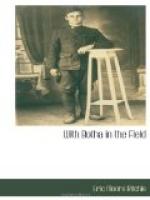There were some skirmishes outside Swakopmund early in February. On the 23rd the Commander-in-Chief took the field; leaving the base shortly after dawn, he carried out a driving movement which pushed the enemy back from the outspan at Nonidas to his posts much further into the desert. In the course of this successful operation we first heard rumours that the Germans as a whole were not anxious to fight. The Union patrols captured several prisoners, amongst whom was an officer with whom I had several chats when I got the opportunity. As was the case with many of the prisoners afterwards taken, for a while he feigned total ignorance of English. It was not long before it became perfectly clear that he of course understood it well.
Following the operations on the 23rd of February, the mounted troops pushed steadily into the desert, occupying with merely nominal resistance Goanikontes, the water-hole and police post at Haigamkhab, and the water-hole at Husab.
On the 18th of March the Commander-in-Chief and Staff, with all forces except those detailed to the base and infantry already holding the line and stores depots, etc., trekked out from Swakopmund on what was officially described as a “reconnaissance.” It was really the first big push into the Namib Desert. The enemy had taken up an extremely strong position on the edge of the desert proper, on the front indicated on the general diagram of the campaign marked Pforte-Jakalswater-Riet.
I have little official knowledge on the tactics of the campaign; it is necessary, however, here to allude to the plan of proceeding known to every one who took any part in it. The vital consideration to the advance of any army across the Namib Desert is to secure the water-holes on the Swakop River. The Swakop is by no means the usual prepossessing kind of stream that flows efficiently between wide banks. It flowed actually for a day just after General Botha landed at Swakopmund—the first and last time, apparently, within the memory of man. But it has water in it nevertheless; and at fixed and charted spots are to be found bore-holes and wells for the convenience of dwellers in the profitless wilderness. The principal wells and holes are at the places marked on the diagram. General Botha’s principal task was to take an army right across the Namib Desert, and to do that he had to capture every water-hole and keep it. It is true that at certain points in the Swakop and other of the large rivers of South-West Africa you can find water by digging very near the surface—perhaps. But when you have a parched army at your back you must deal as little as possible in speculation. At Riet and Jakalswater the enemy had determined to hold the valuable water-holes at any cost, but especially at Riet.




